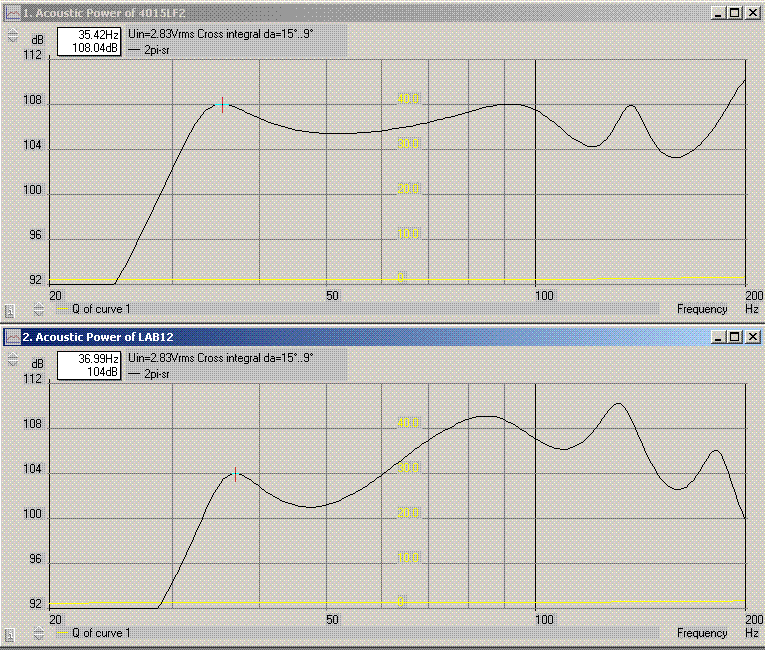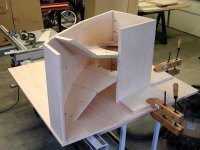I thought he showed 6boxes in 2Pi space and 12boxes flying in 4Pi space."Thomas Danley said there was no advantage to a Tapped Horn once it got to the size of a full horn."
A full LAB 12 horn is eight boxes in 4Pi.
That comes down to 3boxes in Pi space, i.e. up against a wall and sitting on the floor. That's a mighty big speaker ~1.8cub metre (45inch * 45inch * 67.5inch = 79cub feet)
Tried the WayBack machine and found Peter Sylvester's website:
http://web.archive.org/web/*/http://home.comcast.net/~labhorn
http://web.archive.org/web/*/http://home.comcast.net/~labhorn
Found Brad Litz's stuff using the WayBack machine:
Internet Archive Wayback Machine
Brad did a great job but it did get a little more complicated!
Internet Archive Wayback Machine
Brad did a great job but it did get a little more complicated!
Over the last couple of days I've been trying to get a more accurate simulation of the Labhorn by including the offset drivers and breaking the horn into actual segments instead of the previous method of just simulating a hyperbolic flare with 0.5 T.
The first problem is that Danley's specified horn (the design before he folded it) doesn't fit inside a Labhorn sized box. The next problem, as someone else mentioned previously, is that the Labhorn is pretty weird in it's first couple of feet (starting with a throat that's too big, then contracting until it's too small, then expanding again at a rate that quickly makes it too big again, etc, etc.). The third problem - the big one - is that I can't "fix" the Labhorn. There's no room. There's no way I can make the back chambers big enough without changing other parts of the horn for the worse. A full redesign of the folding in a larger overall package would do it, but that's not something I'm really interested in right now.
My next step is to do a complicated but accurate model with Akabak to try to find out what Danley was thinking when he folded it. Maybe there's a couple of folding secrets to be learned here or maybe he just got lazy and didn't do a particularly good job with the fold. The Akabak model won't happen anytime really soon.
As I mentioned previously, I don't care for the v.2 or v.3 options. The v.2 is quite similar to the original and the v.3 makes some changes I'm not comfortable with - and he didn't end up building what he modelled anyway. The v.3 throat comes to a point, so his compression ratio is a lot larger than he thinks (IIRC he stated it was 3:1, and he incorrectly modelled the horn throat as part of the front chambers). That alone isn't necessarily a huge problem, but it doesn't give me any confidence that he knew what he was doing. And the complexity of the v.3 is ridiculous.
In the meantime, I'm also looking into different drivers to use in a Labhorn size box. Mainly looking into single 15 inch drivers like the Eminence 3015. The single 15 won't go quite as loud but a much flatter response is possible and driver cost is cut almost in half.
The first problem is that Danley's specified horn (the design before he folded it) doesn't fit inside a Labhorn sized box. The next problem, as someone else mentioned previously, is that the Labhorn is pretty weird in it's first couple of feet (starting with a throat that's too big, then contracting until it's too small, then expanding again at a rate that quickly makes it too big again, etc, etc.). The third problem - the big one - is that I can't "fix" the Labhorn. There's no room. There's no way I can make the back chambers big enough without changing other parts of the horn for the worse. A full redesign of the folding in a larger overall package would do it, but that's not something I'm really interested in right now.
My next step is to do a complicated but accurate model with Akabak to try to find out what Danley was thinking when he folded it. Maybe there's a couple of folding secrets to be learned here or maybe he just got lazy and didn't do a particularly good job with the fold. The Akabak model won't happen anytime really soon.
As I mentioned previously, I don't care for the v.2 or v.3 options. The v.2 is quite similar to the original and the v.3 makes some changes I'm not comfortable with - and he didn't end up building what he modelled anyway. The v.3 throat comes to a point, so his compression ratio is a lot larger than he thinks (IIRC he stated it was 3:1, and he incorrectly modelled the horn throat as part of the front chambers). That alone isn't necessarily a huge problem, but it doesn't give me any confidence that he knew what he was doing. And the complexity of the v.3 is ridiculous.
In the meantime, I'm also looking into different drivers to use in a Labhorn size box. Mainly looking into single 15 inch drivers like the Eminence 3015. The single 15 won't go quite as loud but a much flatter response is possible and driver cost is cut almost in half.
Last edited:
Just a guy: Simulation is always a compromise.
The proof of the labhorn is that it works. Compromises in the flare rate have little effect on the bottom two octaves, where the labhorn is used.
Brad Litz's (v.3) front chamber is a complex volume that is defined more by the driver's front volumes than the taper of the baffle. The chamber would be better modeled as a soccer ball than a wedge.
I'm sorry I wasted your time, finding the materials you asked for.
The proof of the labhorn is that it works. Compromises in the flare rate have little effect on the bottom two octaves, where the labhorn is used.
Brad Litz's (v.3) front chamber is a complex volume that is defined more by the driver's front volumes than the taper of the baffle. The chamber would be better modeled as a soccer ball than a wedge.
I'm sorry I wasted your time, finding the materials you asked for.
First and foremost this:
I truly appreciate the effort Don, but if you check post #17 I found that stuff almost a week ago and briefly commented on it.
Yes, and it works well. But measurements and simulations and real world thermal overload testimonials show it could work better. It might take a bigger box but it could work better.
Actually, changing the flare rate has a pretty profound effect. I can show you general simulations if you want but I don't have a complex model of the Labhorn worked up yet.
I haven't spent any time trying to model this version. There are several reasons I don't like it much, I just don't like the choices he made.
I'm sorry I wasted your time, finding the materials you asked for.
I truly appreciate the effort Don, but if you check post #17 I found that stuff almost a week ago and briefly commented on it.
The proof of the labhorn is that it works.
Yes, and it works well. But measurements and simulations and real world thermal overload testimonials show it could work better. It might take a bigger box but it could work better.
Compromises in the flare rate have little effect on the bottom two octaves, where the labhorn is used.
Actually, changing the flare rate has a pretty profound effect. I can show you general simulations if you want but I don't have a complex model of the Labhorn worked up yet.
Brad Litz's (v.3) front chamber is a complex volume that is defined more by the driver's front volumes than the taper of the baffle. The chamber would be better modeled as a soccer ball than a wedge.
I haven't spent any time trying to model this version. There are several reasons I don't like it much, I just don't like the choices he made.
Last edited:
You can model any shape if you have enough sections available. All it takes is a little time, and effort.See Danley's comments about "stepped" horns. Also, look at Brad Litz's front chamber ... how could you model that as a pointed wedge?
Here ya go, DBH-218
No doubt. Problem fixed.
Saw that a few weeks ago. Should murder the older Labsub in most aspects in the same size cabinet. Just looking at the drivers... >2x the cone area, 3x the driver displacement, dual > 5" vc's versus 3"ers for less thermal compression. People can talk about the cabinet having a better more coherent match to the drivers, etc, but advantages like those above can't be ignored. Even if the overall sensitivity is a bit less, power is cheap these days and those will no doubt handle it much better than the lab 12's. Dare I say that DSL is starting to design their subs the way I would like them to with this one and the TH118, TH221? I always thought that they held themselves back a little from what was possible with their driver choices in their cabs.
- Status
- This old topic is closed. If you want to reopen this topic, contact a moderator using the "Report Post" button.
- Home
- Loudspeakers
- Subwoofers
- Fixing the Labhorn?

